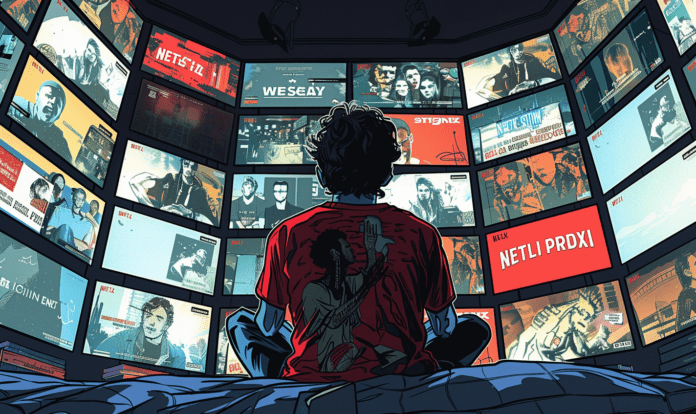Netflix is slapping the streaming world around, reigning supreme like a binge-watching overlord and making corporate boardrooms and basement couches equally attentive.
With its ad-supported tier, the streaming behemoth has gone from playing it cool to full throttle on the gas pedal, sucking in advertisers like a blockbuster premiere sucks in viewers.
This isn’t just growth; it’s an explosion—40% of new sign-ups are opting for ads with their drama, and that’s just the teaser.
The Mad Rush to Advertise: A Goldmine Unearthed
Netflix’s jump into the advertising pool is less a cautious toe dip and more of a meteoric belly flop that reverberates through the media landscape. It’s not just opening its doors to advertisers—it’s rolling out a red carpet lined with LED screens, beckoning brands to broadcast their latest and greatest to the binge-watching masses. With a burgeoning base of 23 million ad-watching, popcorn-popping subscribers, Netflix has transformed from mere entertainment provider to a titan of targeted advertising. Imagine the most addictive series mingling with sneakily placed ads that viewers actually want to see—this isn’t accidental; it’s ad-genius at work.
This isn’t your old-school TV ad break; this is strategic ad placement elevated to an art form. Brands are clamoring for a spot not just between shows but as part of the Netflix experience—a seamless blend that might have you wondering whether you’re still watching your favorite drama or if you’ve wandered into an extended car commercial. With a user base glued to their screens for hours on end, advertisers have the perfect setup to make their pitch. It’s a captive audience that’s literally captive, trapped in their Netflix-induced euphoria.
And with numbers like these, who needs a Super Bowl spot when you have a mid-season cliffhanger of “Ozark” to slot your product into?
But what really turns the Netflix platform into a goldmine for advertisers isn’t just the sheer numbers—it’s the quality of the engagement. Subscribers aren’t just idly flipping channels or skipping ads with the touch of a button; they are engrossed, immersed, and engaged. This high level of viewer investment creates an advertiser’s paradise, where every ad has the potential to be as impactful as the plot twist in “Black Mirror.” Netflix has cracked the code, turning what could have been a necessary evil into a coveted slot on prime time’s new age. As brands dive into this deep pool of opportunity, Netflix sits back and watches the stakes—and the stocks—rise.
Engagement or Bust: The Viewer’s Dilemma
This isn’t about shoving pizza ads in the middle of “The Crown.” Netflix’s ad mojo is about turning necessary evils (yes, ads are still that) into moments of marketing genius. It’s about making viewers love ads the way they love plot twists. Netflix has turned watching ads into something you endure with the promise of narrative payoff—like finding out if your favorite character survived the cliffhanger while munching on the branded popcorn the previous ad just convinced you to buy.
Gone are the days of simple intermissions; now, ads are integrated so smoothly into your viewing marathon that you might find yourself reaching for products as instinctively as you reach for the remote. This platform isn’t just selling you a pause filled with product pitches; it’s selling a sophisticated, almost sublime interruption that might just enhance your viewing pleasure. Imagine being wrapped up in the suspense of a thriller when an impeccably timed ad for home security systems pops up—suddenly, the ad isn’t an interruption, it’s an augmentation of your adrenaline.
But the true magic of Netflix’s ad integration lies not in the obvious placements but in the subtle art of keeping viewers hooked. The company has essentially redefined what it means to watch TV by making advertisements a part of the binge-watching ritual. This approach is a gamble—will viewers accept these commercial co-stars or will they rebel against the intrusion into their carefully curated escapism? Netflix bets on the former, aiming to make ads as much a part of the landscape as the opening credits. And surprisingly, many viewers aren’t just tolerating this new arrangement; they’re engaging with it, making mental notes of brands and products that resonate with the content they love.
Navigating this new ad-infused reality, Netflix has to tread carefully to maintain the delicate balance between keeping shows binge-worthy and turning them into prolonged commercial breaks. Viewer patience is not infinite, and the tolerance for ads can wear thin if the balance tips too far towards commercialism.
However, Netflix’s knack for narrative does give it a unique edge—ads aren’t just sandwiched between episodes; they are crafted to fit within the viewing ecosystem, intended to complement rather than disrupt. This seamless integration is the linchpin in Netflix’s strategy, aiming to transform passive watchers into active, engaged consumers who feel that even the ads are a part of their Netflix journey.
Netflix Stops Counting Subscribers: A Numbers Game No More
In a plot twist worthy of its own Netflix original, the streaming giant has decided that subscriber numbers are so last season. Starting in 2025, Netflix will toss the traditional tally sheet out the window, opting instead to focus on… well, something else. This bold move is like a magician pulling a disappearing act on the audience count while everyone’s still clapping—it’s daring, a little baffling, and might just be a stroke of genius. Instead of playing the numbers game where every subscriber is a notch on the bedpost, Netflix is now all about the “other metrics,” a mysterious mix that’s less about how many are watching and more about how well they watch. It’s a high-stakes gamble to redefine success, hoping that depth beats breadth when it comes to viewer engagement.
So, what’s driving this seismic strategy shift? Maybe Netflix is tired of the same old scorekeeping, or maybe it’s a clever sidestep in a world where the competition is just too keen to play fair. Whatever the case, this isn’t just about changing the rules; it’s about changing the game. By unshackling itself from subscriber counts, Netflix is free to explore new realms—think viewer satisfaction levels, engagement juice, or any kind of avant-garde analytics that tech heads can dream up. It’s a move that could either be a masterclass in modern media metrics or a flub of epic proportions
Show Me the Money: The Strategy Behind the Screen
But in the past, netflix’s subscriber figures are more than just bragging rights; they’re a colossal billboard for its newfound ad-centric business model. With a whopping 260.8 million pairs of eyes glued to their screens, Netflix isn’t just streaming; it’s screaming its potential from the digital rooftops. This isn’t merely about quantity, though. The quality of these viewers—engaged, dedicated, and more prone to bingeing than a dieter in a doughnut shop—makes them prime targets for advertisers. Netflix has crafted a gold-plated invitation to marketers: Come place your ads where the viewers are not just plentiful, but passionate. This strategic shift is a clear move from playing defense with subscription-only content to an aggressive offense, blending subscription fees with ad revenue streams.
In this new, ad-augmented realm, Netflix has reimagined the value proposition of its platform. Each show isn’t just a potential fan favorite; it’s a vehicle for high-impact advertising. The environment is pristine: high-quality original content serves as the perfect backdrop for equally polished ads. It’s a marketer’s dream—premium content married to premium advertising opportunities.
This isn’t about throwing spaghetti at the wall to see what sticks; it’s about placing each ad with precision, ensuring that messages not only reach viewers but resonate on a deeper, almost personal level. Netflix’s content strategy has become a dual-purpose engine, driving both viewer engagement and ad integration, a twin-turbo approach to keeping the lights on and the cameras rolling.
Yet, with great power comes great scrutiny.
As Netflix pads its bottom line with ad dollars, it walks a tightrope of viewer expectations and advertiser demands. The challenge is monumental: maintaining the integrity of its content while monetizing every possible moment without alienating its base.
Subscribers came for the drama, not the commercials; keeping them subscribed (and subscribing to ads) is a narrative twist even Netflix’s best writers might struggle to perfect long term.
The company must continue to innovate not just in how content is created but how it’s monetized, ensuring the ads are as unobtrusive as they are unavoidable. It’s a high-stakes game of show and sell, one that could redefine how stories are told and sold on the silver screen of streaming.
A Whole New World for Advertisers
Netflix’s ad landscape is like the Wild West, but with better production value and fewer shootouts. It’s a new frontier, unspoiled by the usual ad-slinging suspects. Here, a brand can be more than background noise; it can be part of the binge-watch routine. Netflix offers a rare blend of reach, engagement, and a little bit of that showbiz sparkle—a combination that’s as enticing to advertisers as a cliffhanger is to viewers.
This isn’t merely adding a splash of commercial to your viewing cocktail; it’s about integrating advertisements so smoothly that you’ll think they were part of the showrunner’s vision. Imagine a suspense thriller that cuts to a sleek, dark-toned car advertisement just as the tension peaks—suddenly, you’re not just an observer; you’re part of a cinematic journey where even the ads are part of the narrative.
In this lush landscape, ads aren’t interruptions; they’re extensions of the viewing experience. Netflix has crafted an environment where ads are tailored to the mood and theme of the show you’re watching, making them feel less like commercial breaks and more like part of the storyline. This seamless integration helps maintain the flow of binge sessions, reducing the mental switch viewers typically feel when moving from story to selling. It’s a subtle art—ensuring that each advertisement is not only seen but felt as a continuation of the viewer’s emotional engagement. Here, advertisers have the unique opportunity to resonate deeply with audiences, embedding their messages within the context of highly curated content.
Netflix’s strategy cleverly capitalizes on its audience’s habits by offering brands a shot at premium placement among the most popular series and films. This access turns each ad spot into prime real estate, coveted by marketers who dream of their products sharing the screen with the likes of “Stranger Things” and “The Crown.” The strategic placement of these ads means they’re more likely to be watched and less likely to be skipped, providing an effectiveness that can’t be matched by more traditional, disruptive advertising methods. This is the streaming behemoth’s version of a win-win: viewers stay glued to their screens, and brands get the eyeballs they so desperately crave.
But Netflix’s ad-rich utopia doesn’t just benefit from high viewer engagement. It also offers advertisers unparalleled diversity in audience demographics. With a global subscriber base that spans various ages, interests, and countries, brands can target their ads with unprecedented precision. Whether it’s reaching millennials with tech gadgets or boomers with luxury cars, Netflix’s ad algorithms provide a scalpel where once there was only a sledgehammer. This nuanced approach allows for more strategic advertising campaigns that are fine-tuned to the viewer’s profile, increasing the chances of conversion and brand loyalty.
Navigating this new ad-scape requires a boldness typical of Netflix’s own disruptive history. For advertisers, it’s about more than just buying space; it’s about creating moments that are as compelling as the content they accompany. As Netflix continues to expand its advertising capabilities, the opportunities for innovative marketing will likely grow, offering new ways to engage audiences that go beyond the screen. Advertisers ready to embrace this evolution will find themselves at the forefront of a revolution in digital advertising, crafting experiences that entertain, engage, and elevate the commercial to something close to cinematic art.
Peering into the Crystal Ball: Netflix’s Ad-Filled Future
Netflix is eyeballing the future of advertising with the smugness of a cat who got the cream. It’s not just changing the channel; it’s smashing the remote. The streaming giant’s move from obsessing over subscriber numbers to geeking out over engagement metrics is like watching a magician swap rabbits for doves mid-act—it’s unexpected, slightly confusing, but undeniably slick. Netflix is concocting a world where ads aren’t just endured, they’re part of the spectacle, woven into your binge-watching sessions as snugly as your favorite throw blanket. With this new strategy, they’re not just hoping you’ll tolerate the intrusion; they’re betting you’ll ask for seconds, creating a viewer-advertiser lovefest that could set the standard for how ads are integrated into media.
This ain’t your grandma’s ad model; it’s a beast of a different breed. As Netflix struts further down this path, we can expect it to slap traditional ad formats in the face with innovations that could make ads as engaging as the shows they interrupt. Imagine interactive ads that let you choose your own adventure—tap here to keep the romantic subplot, swipe there to ditch the annoying side character, all while seamlessly plugging a product. Netflix could leverage its treasure trove of data to not just target ads but to make them feel like a personal shoutout from your favorite character, blurring the lines between content and commerce in ways that could make even the most ad-averse viewer crack a smile. The future of Netflix ads looks less like a necessary evil and more like a weirdly enjoyable part of your streaming diet.
Netflix is sailing into uncharted waters with its flashy ad-tier ship, and let’s just say, the seas could get a bit rough. It’s not just about throwing some ads into the mix and calling it a day; it’s about keeping the binge-boat steady while tossing in commercials without making viewers seasick. They’ve got the content down—more hooks than a pirate’s convention—but mixing in ads without upsetting the binge-watchers’ delicate diet of drama and docs? That’s the real trick. This balancing act is part diplomacy, part tightrope walking, and all eyes are on Netflix to see if they can keep the party going without turning it into an ad-laden float parade that sends viewers jumping ship.
As Netflix steers this course, it’s got to dodge icebergs like ad fatigue and viewer backlash. There’s a fine line between cleverly integrated and outright intrusive, and straying too far into commercial waters could be disastrous. The challenge isn’t just to keep the ads coming but to keep them as unobtrusive and as engaging as possible. They need ads to blend in like camouflage, not stick out like a sore thumb. If the viewers start feeling like they’re just fodder for the ad cannon, they’ll bail, and no amount of algorithmic prowess or strategic brilliance will bring them back to the fold. Netflix needs to navigate these waters with the finesse of a seasoned captain, ensuring that every ad-break is as smooth as a good scotch, not a jarring jolt back to reality.
Yet, amidst these challenges, Netflix has an ace up its sleeve—their unparalleled data on viewer habits and preferences. This isn’t just about using big data to target ads; it’s about creating a viewer experience so tailored and so spot-on that even the ads feel like part of the show. Imagine ads so integrated that you don’t know where your latest binge ends and the persuasion begins. If Netflix can pull this off, it could redefine viewer engagement, making its platform not just a place to watch shows but a hub of interactive, almost enjoyable ad experiences.
It’s a bold vision, but if anyone can lead this new age of ad-supported streaming without capsizing, it’s Netflix, with its compass set firmly on innovation and its sails filled with the winds of viewer data.

























